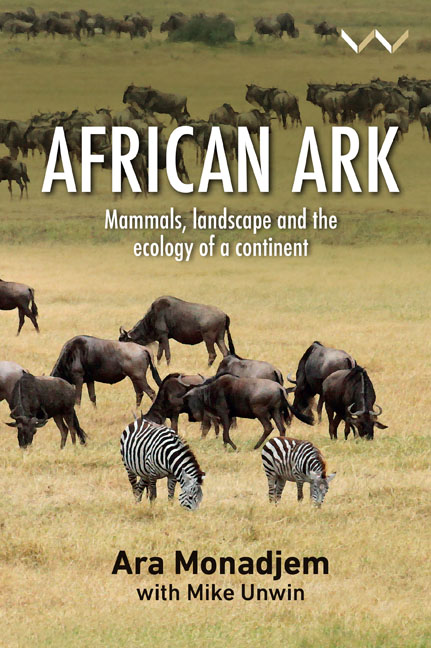Book contents
- Frontmatter
- Dedication
- Contents
- List of Plate Photographs
- List of Figures and Tables
- Acknowledgements
- Foreword
- Preface
- Chapter 1 A Continent of Plenty
- Chapter 2 The Species Conundrum
- Chapter 3 The History of Africa’s Mammals
- Chapter 4 Islands as Species Factories
- Chapter 5 Evolution on the African Mainland
- Chapter 6 Giant Mammals Shaping the Landscape
- Chapter 7 A Place for Every Species
- Chapter 8 Fluctuating Populations
- Chapter 9 The Human Factor
- Chapter 10 The Sinking Ark?
- Glossary
- Notes
- References
- Recommended Reading
- Index
Chapter 6 - Giant Mammals Shaping the Landscape
Published online by Cambridge University Press: 29 November 2023
- Frontmatter
- Dedication
- Contents
- List of Plate Photographs
- List of Figures and Tables
- Acknowledgements
- Foreword
- Preface
- Chapter 1 A Continent of Plenty
- Chapter 2 The Species Conundrum
- Chapter 3 The History of Africa’s Mammals
- Chapter 4 Islands as Species Factories
- Chapter 5 Evolution on the African Mainland
- Chapter 6 Giant Mammals Shaping the Landscape
- Chapter 7 A Place for Every Species
- Chapter 8 Fluctuating Populations
- Chapter 9 The Human Factor
- Chapter 10 The Sinking Ark?
- Glossary
- Notes
- References
- Recommended Reading
- Index
Summary
For at least two hundred million years our planet was dominated by organisms so massive that modern elephants look quaintly diminutive by comparison. Lumbering sauropods, weighing dozens of tons, roamed Earth as Pangaea fractured and the fragments drifted apart, eventually forming the continents we are familiar with today. Argentinosaurus, for example, was more than 30 metres in length and is estimated to have weighed 73 tons (Mazzetta et al. 2004). The end-Cretaceous mass extinction that took place 66 million years ago saw the complete disappearance of all these giant dinosaurs, but the resulting vacuum was quickly, in evolutionary terms, filled by mammals. Previously, the largest mammals had weighed less than 10 kilograms (little more than a domestic cat), but in less than 25 million years there were species weighing 10 tons – double the size of a large savanna elephant. Thus, by 40 million years ago, our planet was once again home to enormous creatures, but this time they were mammalian, rather than dinosaurian/reptilian, in nature. Considering the very long relationship that megafauna have had with our planet, you might imagine that they have played an integral role in shaping and maintaining its terrestrial ecosystems. And you would be right. Only now are we beginning to piece together the critical functions that megafauna provide – or, more correctly, provided, since sadly most of these huge animals are no longer with us. To understand why this is so, we need to look at human history, particularly the happenings of the past 50 000 years.
HUGE MAMMALS OF THE PAST: EXTINCT MEGAFAUNA
What exactly do we mean by ‘megafauna’? The term typically refers to any large terrestrial animal weighing more than one ton (N. Owen-Smith 1987; R.N. Owen Smith 1992). In fact, the term ‘megaherbivore’ was coined by Norman Owen-Smith, a brilliant ecologist, now retired from the University of the Witwatersrand in Johannesburg, South Africa. I was lucky enough to complete my master's degree under his supervision but, unhappily, did not study his key papers until many years later. Today, megafauna encompass just four groups of terrestrial mammals: elephants, rhinoceroses, hippopotamuses and giraffes. But giant mammals abounded until recent times – recently enough for our species to have encountered them – and included many other groups. Some of these vanished giants were many times larger than the largest extant megafauna.
- Type
- Chapter
- Information
- African ArkMammals, Landscape and the Ecology of a Continent, pp. 125 - 148Publisher: Wits University PressPrint publication year: 2023

